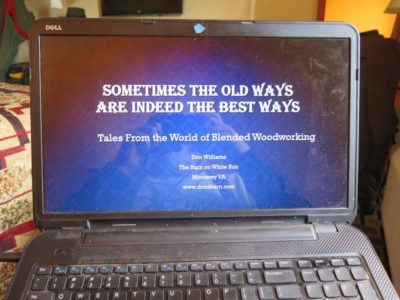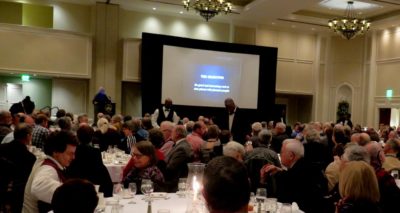Williamsburg Snapshot – The Banquet

For me the great honor at Working Wood in the 18th Century was being asked to serve as the after dinner speaker. Kaare had asked me to work with the topic “sometimes the old ways are the best ways” to which I gladly complied. Of course I provided my own peculiar spin on the topic, but everyone seemed to laugh in all the right places so I guess it went well.

Of course the highlight of the evening was the scrumptious chocolate cheesecake awaiting me at my place on completion of the chat.
I got a lot of very positive feedback on the talk, and was even asked to summarize part of it as an article in next year’s American Period Furniture. That section of greatest interest was a list of ten “assignments” I gave to the audience to stretch their handworking boundaries. For some in the audience, perhaps even most, this was simple encouragement and validation, for others it was a legitimate challenge.
I will blog about each of those assignments individually over the next fortnight or so, but here is the list:
- Restore an old tool to wondrous functionality
- Make a new tool and incorporate it into your bench work
- Learn to sharpen. Really. Everything
- Incorporate one (then all) of these traditional tools into your work — spokeshave, drawknife, scratch stock, toothing plane, froe
- Saw and prepare veneers by hand
- Learn to prepare, modify, and manipulate and use hot hide glue. Then use it.
- Execute a decorative painted surface
- Make from scratch, from stock you prepare yourself, one of the following — parquetry, floral marquetry, Boulle-work, a Federal paterae
- Prepare a surface without the benefit of sandpaper, then apply a finish not using a spray gun, polyurinate, or cellulose nitrate
- Make a piece of furniture entirely without power tools, beginning with a piece of firewood or similar



Join the Conversation!